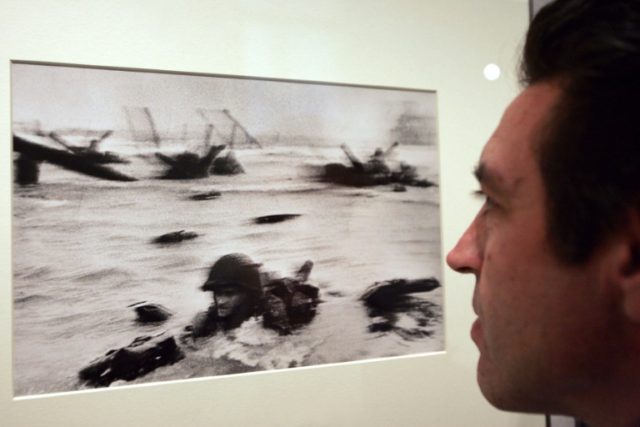Paris (AFP) – When Allied troops hit the beaches of Normandy on June 6, 1944, some now-legendary reporters and photographers were on hand to produce the first draft of history.
– Robert Capa –
Hungarian-born photographer Capa shot the most famous photograph from the landings: blurry and dark, it shows an infantryman crouched in the water amid tank traps, as shells explode and bullets fly.
A veteran of the Spanish Civil War, Capa was the only photographer in the first wave of landings on Omaha Beach, working for Life magazine alongside US troops with a Leica that produced a little more than 100 images over a six-hour span.
“If your pictures aren’t good enough, you aren’t close enough,” is one of Capa’s enduring quotes.
Back in London, a lab technician’s drying error destroyed most of the images, leaving less than a dozen undamaged ones to be viewed and sent around the world.
– Ernest Hemingway –
Hemingway tracked the D-Day landings through binoculars from a landing craft off Omaha Beach — the unimpressed military brass refusing to allow him ashore — and wrote a dramatic first-person account entitled “Voyage to Victory”.
The already well-known American journalist was able to join up with US troops later in the operation, going on to witness the liberation of Paris in August.
Reports that he was the first into the French capital and “liberated” the bar at the Hotel Ritz remain unconfirmed.
– Walter Cronkite –
Dubbed “The most trusted man in America”, Cronkite worked in the 1930s for the news agencies Scripps-Howard and United Press (UP).
He is said to have written the first dispatch from the Normandy beaches, bucking convention with first-person reports.
Cronkite later covered the Nuremberg war trials and was UP’s Moscow bureau chief from 1946 to 1948, being lured back to New York by CBS Television.
Of all the stories he reported on, from wars in Korea and Vietnam to the assassination of President John Kennedy, he said D-Day had marked him the most.
– Martha Gellhorn –
Hemingway’s estranged American wife at the time, Gellhorn did not get official permission to cover the landings so stowed away on a hospital ship, where she hid overnight in a toilet.
She was able to get ashore briefly, wading out disguised as a stretcher-bearer with the ambulance teams that left the ship to fetch casualties from Omaha Beach.
Gellhorn was the only woman to cover the D-Day landings, going on to achieve an international reputation as a war reporter.
Gellhorn was the only woman to cover the D-Day landings, going on to achieve an international reputation as a war reporter.
– Richard Dimbleby –
The BBC’s first war correspondent started the day reporting in the early hours from a Royal Air Force base from where bombers carrying 24,000 British, US and Canadian paratroopers headed for Occupied France.
He later flew over with the British army and reported from the landing beaches, going on to cover the rest of the operation to liberate northwestern Europe from the Nazis.
He was the first correspondent to enter the SS Bergen-Belsen concentration camp, liberated by British troops in 1945, and described scenes of horror in one of his most memorable reports.
– Samuel Fuller –
Writer and filmmaker Fuller was an army corporal on Omaha Beach with the 1st Infantry Division that was nicknamed as “The Big Red One” and later became the subject and title of his best-known movie, released in 1980 and starring Lee Marvin.
Fuller’s training as a New York crime reporter did not prepare him for the fighting he saw in North Africa, Sicily or Normandy, he said later.
He was wounded twice and won a Purple Heart, a Bronze Star and a Silver Star for bravery.

COMMENTS
Please let us know if you're having issues with commenting.